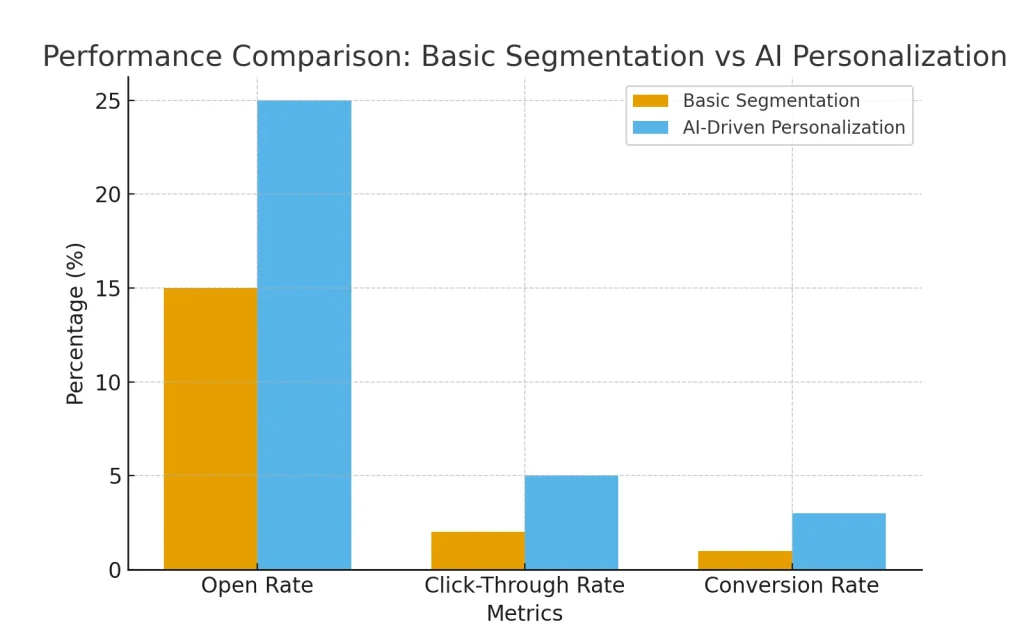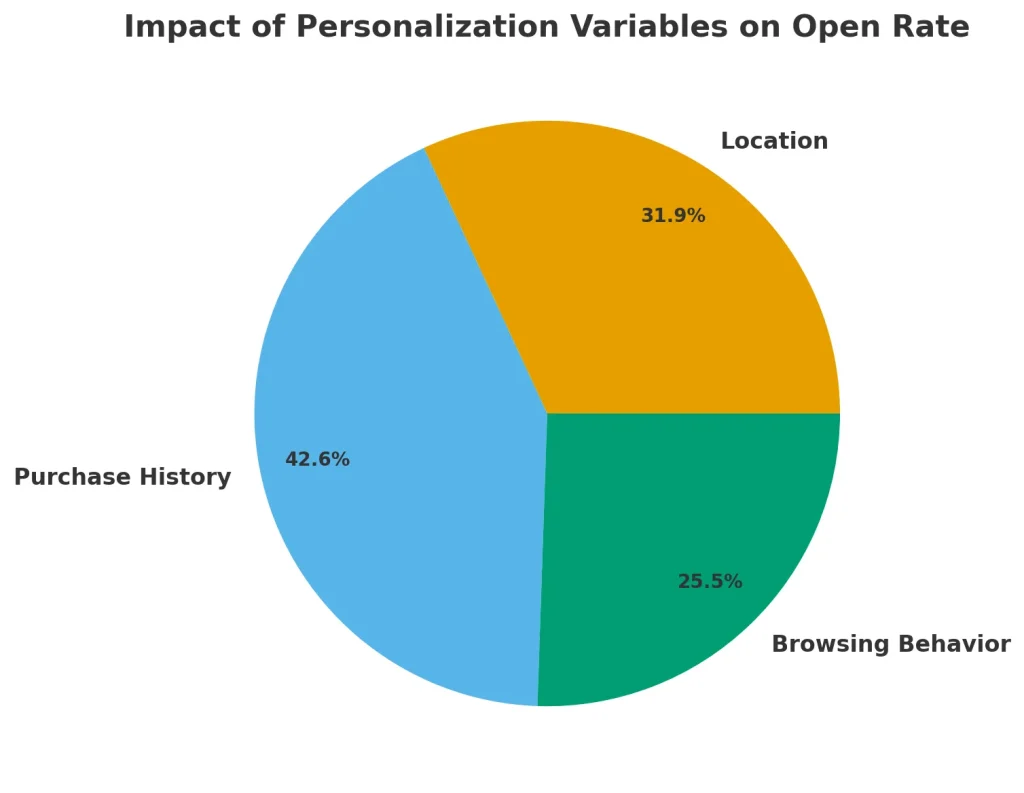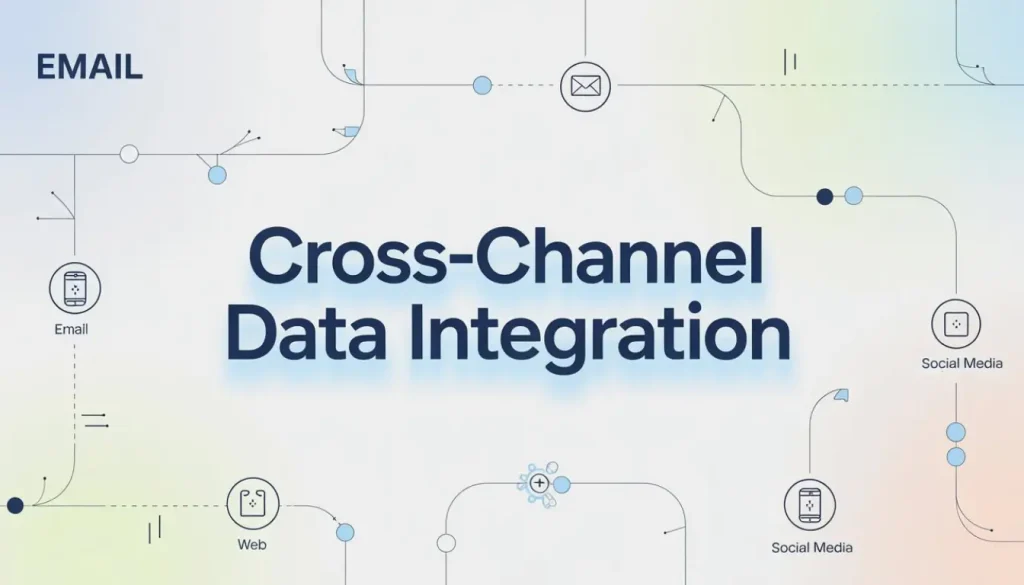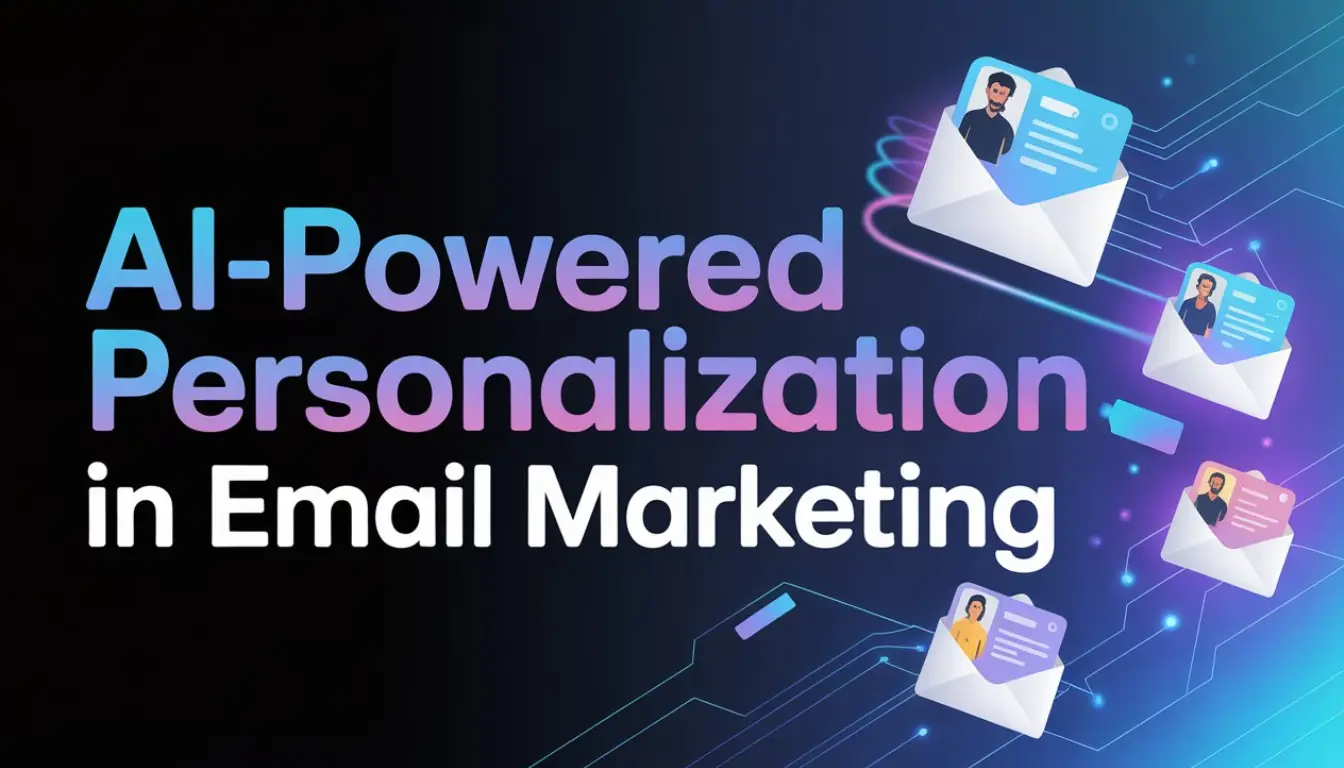You are on the cusp of a revolution in email marketing, one that leverages the power of AI email personalization to transform how businesses connect with their customers.
By harnessing predictive analytics and dynamic content, you can create highly targeted campaigns that resonate with your audience, driving engagement and conversion.
Key Takeaways
- Discover how AI-driven personalization can revolutionize your email marketing strategies.
- Learn about the role of predictive analytics in creating targeted campaigns.
- Understand the importance of dynamic content in enhancing customer engagement.
- Explore the potential benefits of AI-powered personalization for businesses.
- Gain insights into implementing AI-driven email marketing solutions.
Revolutionize Your Email Marketing with AI Personalization
Harness predictive analytics and dynamic content to deliver smarter, more engaging customer experiences.
The Evolution of Email Marketing Personalization
Email marketing personalization has undergone significant transformations since its inception, evolving from simple techniques to sophisticated AI-driven strategies. This evolution has been crucial in enhancing customer engagement and improving key email marketing metrics.
From Basic Segmentation to AI-Driven Personalization
Initially, email marketing personalization began with basic segmentation, where customers were grouped based on simple criteria like demographics or purchase history. However, with the advent of AI, personalization has become more sophisticated, allowing for real-time data analysis and highly targeted campaigns.
The Impact of Personalization on Email Marketing Metrics
Personalization has significantly impacted key email marketing metrics. By leveraging AI, businesses can improve open rates, click-through rates, and conversion rates.
Open Rate Improvements
AI-driven personalization helps in crafting subject lines that are more relevant to the recipient, thus improving open rates. Studies have shown that personalized subject lines can increase open rates by up to 50%.
Click-Through Rate Enhancements
By personalizing email content based on user behavior and preferences, businesses can significantly enhance click-through rates. AI algorithms analyze user data to determine the most effective content and layout.
Conversion Rate Optimization
AI-driven personalization also optimizes conversion rates by ensuring that the email content is highly relevant to the recipient’s needs and interests. This leads to higher conversion rates and ultimately, increased revenue.
| Metric | Basic Segmentation | AI-Driven Personalization |
|---|---|---|
| Open Rate | 15% | 25% |
| Click-Through Rate | 2% | 5% |
| Conversion Rate | 1% | 3% |

Understanding AI Email Personalization Technologies
Understanding the technologies behind AI email personalization is crucial for businesses aiming to enhance customer engagement. AI email personalization technologies have transformed the landscape of email marketing by enabling businesses to create highly tailored content for their customers.
Machine Learning Algorithms in Email Marketing
Machine learning algorithms play a pivotal role in AI email personalization. These algorithms analyze customer data to predict preferences and behaviors, allowing for personalized email recommendations. By leveraging machine learning, businesses can automate the personalization process, making it more efficient and effective.
Natural Language Processing for Content Optimization
Natural Language Processing (NLP) is another key technology in AI email personalization. NLP enables the analysis and generation of human-like text, optimizing email content to better resonate with recipients. This technology helps in crafting subject lines, email copy, and calls-to-action that are more likely to engage customers.
Computer Vision in Email Design
Computer vision is increasingly being used in email marketing to analyze and optimize visual elements. This involves:
- Image Recognition and Optimization: AI can analyze images to ensure they are relevant and appealing to the recipient.
- Visual Preference Analysis: By analyzing how recipients interact with visual elements, businesses can tailor their email designs to better meet customer preferences.
As highlighted by a recent study, “AI-driven personalization can lead to a significant increase in customer engagement and conversion rates.” (
Forbes
). By understanding and leveraging these AI email personalization technologies, businesses can create more effective email marketing campaigns.
| Technology | Application in Email Marketing |
|---|---|
| Machine Learning | Personalized Recommendations |
| NLP | Content Optimization |
| Computer Vision | Visual Element Analysis |
Leveraging Predictive Analytics for Customer Insights
Predictive analytics is revolutionizing the way businesses understand their customers, enabling more personalized and effective email marketing strategies. By analyzing historical data and identifying patterns, predictive analytics helps marketers anticipate customer needs and tailor their campaigns for maximum impact.
Anticipating Customer Needs and Behaviors
Predictive analytics allows businesses to forecast future customer behaviors, such as likelihood to purchase or churn. This enables marketers to proactively address customer needs, improving overall customer satisfaction and loyalty.
Predictive Customer Lifetime Value Models
Predictive Customer Lifetime Value (CLV) models help businesses identify their most valuable customers and tailor their marketing efforts accordingly. By understanding the potential lifetime value of each customer, marketers can allocate resources more effectively.
| Customer Segment | Predicted CLV | Marketing Strategy |
|---|---|---|
| High-Value Customers | $1,000+ | Personalized Offers, Priority Support |
| Mid-Value Customers | $500-$999 | Targeted Promotions, Regular Engagement |
| Low-Value Customers | <$500 | Re-engagement Campaigns, Educational Content |
Churn Prediction and Prevention Strategies
Predictive analytics also enables businesses to identify customers at risk of churning. By recognizing early warning indicators, marketers can implement targeted retention strategies to prevent customer loss.
Early Warning Indicators
- Decrease in purchase frequency
- Reduction in engagement metrics (e.g., opens, clicks)
- Changes in customer support interactions
Re-engagement Campaign Automation
Automated re-engagement campaigns can be triggered by predictive models identifying customers at risk of churn. These campaigns can include personalized offers, content recommendations, or surveys to re-establish customer connection.
By leveraging predictive analytics, businesses can make data-driven decisions to enhance customer relationships and improve email marketing effectiveness. This proactive approach enables marketers to stay ahead of customer needs, driving long-term growth and loyalty.
Transform Customer Engagement Through AI-Driven Emails
Discover how machine learning and real-time personalization can boost open rates and conversions.
Creating Dynamic Content with AI
AI is revolutionizing email marketing by enabling the creation of dynamic content that resonates with individual customers. This transformation is driven by advanced technologies that allow for real-time personalization and automated content generation.
Automated Content Generation Tools
Automated content generation tools use AI to create email content that is tailored to the recipient’s preferences and behaviors. These tools can generate product descriptions, promotional messages, and even entire email campaigns with minimal human intervention. According to a recent study, businesses that use automated content generation have seen a 25% increase in email engagement.
Real-time Content Personalization
Real-time content personalization involves adjusting email content based on the recipient’s current behavior or context. This can include personalized product recommendations, location-specific offers, or time-sensitive promotions. As noted by “Email Marketing Trends”, real-time personalization can lead to a 50% higher open rate compared to non-personalized emails.

Product Recommendation Engines
Product recommendation engines are a crucial component of dynamic content in email marketing. These engines use AI algorithms to suggest products that are likely to interest the customer based on their past purchases, browsing history, and other behavioral data.
Collaborative Filtering Techniques
Collaborative filtering techniques involve analyzing the behavior of similar customers to make recommendations. This method is widely used in e-commerce and has proven to be highly effective in increasing sales and customer satisfaction.
Content-Based Recommendation Systems
Content-based recommendation systems focus on the attributes of the products themselves to make recommendations. By understanding the features that a customer prefers, these systems can suggest relevant products, enhancing the personalization of email content.
By leveraging these AI-driven technologies, businesses can create highly engaging and personalized email marketing campaigns that drive better results. As the landscape of email marketing continues to evolve, the role of AI in creating dynamic content will become increasingly important.
“The future of email marketing lies in its ability to personalize content at scale, and AI is the key to making this happen.”
AI-Powered Email Send Time Optimization
By leveraging AI, businesses can now optimize their email send times to reach customers when they’re most receptive. This approach ensures that emails are sent at moments when customers are likely to engage with them, thereby increasing the effectiveness of email marketing campaigns.
Individual Send Time Optimization
AI algorithms analyze customer behavior to determine the optimal send time for each individual. This personalized approach considers factors such as past interactions, purchase history, and engagement patterns to maximize the likelihood of emails being opened and acted upon.
Behavioral Pattern Recognition
AI-powered systems identify complex behavioral patterns among customers, enabling businesses to send emails at times when they are most likely to be engaged. This could be during their daily commute, lunch break, or late evening, depending on their historical behavior.
Time Zone and Activity-Based Scheduling
AI also considers time zone differences and schedules emails accordingly, ensuring that they are sent at appropriate times for each recipient. Additionally, activity-based scheduling sends emails based on specific customer activities, such as abandoning a cart or visiting certain web pages.
By implementing AI-powered email send time optimization, businesses can significantly enhance the impact of their email marketing efforts, leading to higher engagement rates and ultimately, more successful campaigns.
Personalized Subject Lines and Preheaders
AI-driven personalization is revolutionizing email subject lines and preheaders, making them more effective at capturing the attention of recipients. By leveraging advanced algorithms and machine learning, businesses can now create highly personalized subject lines that significantly improve email open rates.
AI-Generated Subject Line Testing
One of the key benefits of AI in email marketing is its ability to generate and test multiple subject line variations. This process involves creating numerous subject lines based on different variables such as keywords, phrases, and emotional triggers. AI then analyzes the performance of these subject lines across different segments of your audience, identifying which ones yield the highest open rates.
Emotional Analysis for Higher Open Rates
AI-powered emotional analysis can further enhance subject line effectiveness by assessing the emotional impact of different words and phrases. By understanding how various emotional triggers resonate with your audience, you can craft subject lines that not only grab attention but also elicit the desired response.
Personalization Variables Beyond First Name
While using a recipient’s first name is a basic form of personalization, AI enables you to go beyond this by incorporating other personalization variables. These can include location-specific information, purchase history, browsing behavior, and more. By integrating these variables into your subject lines and preheaders, you can create a more tailored and engaging experience for your recipients.
| Personalization Variable | Example | Impact on Open Rate |
|---|---|---|
| Location | “Exclusive Offer for [City] Residents” | +15% |
| Purchase History | “Recommended Products Just for You” | +20% |
| Browsing Behavior | “Complete Your Latest Purchase” | +12% |
By incorporating these advanced personalization techniques into your email marketing strategy, you can significantly enhance the effectiveness of your campaigns, leading to higher open rates, increased engagement, and ultimately, improved conversion rates.

Implementing AI Email Personalization for Businesses of All Sizes
AI email personalization is no longer a luxury for large enterprises; businesses of all sizes can now leverage this technology to boost their marketing efforts. As the digital landscape continues to evolve, companies are recognizing the importance of tailored email campaigns in driving customer engagement and conversion.
Solutions for Small Businesses
For small businesses, implementing AI email personalization can seem daunting due to limited resources. However, there are cost-effective solutions available:
Cost-Effective AI Tools
- Mailchimp’s AI-powered email marketing tools
- HubSpot’s free CRM with AI-driven email personalization
- Sendinblue’s AI-based email automation
Outsourcing vs. In-House Implementation
Small businesses must decide whether to outsource AI email personalization or implement it in-house. Outsourcing can provide access to expertise and technology without significant upfront costs, while in-house implementation offers more control over the process.
Mid-Market Company Strategies
Mid-market companies have more resources at their disposal, allowing for more sophisticated AI email personalization strategies. These can include:
- Advanced segmentation using machine learning algorithms
- Personalized content generation based on customer behavior
- A/B testing of AI-driven email campaigns
Enterprise-Level Implementation Roadmaps
For large enterprises, implementing AI email personalization requires a comprehensive approach. This involves:
- Data integration across multiple channels and systems
- Development of complex AI models tailored to specific customer segments
- Continuous monitoring and optimization of email campaigns
By understanding the unique challenges and opportunities associated with their size, businesses can effectively implement AI email personalization strategies that drive results.
Data-Driven Email Marketing Strategies
In today’s digital landscape, data-driven email marketing strategies are revolutionizing how businesses connect with their audience. By leveraging comprehensive customer data, marketers can create highly personalized and effective email campaigns that drive engagement and conversion.
Building Comprehensive Customer Profiles
Building comprehensive customer profiles is crucial for data-driven email marketing. This involves collecting and integrating data from various sources to create a 360-degree view of your customers. Key data points include:
- Demographic information
- Purchase history
- Browsing behavior
- Email engagement metrics
By analyzing these data points, marketers can identify patterns and preferences that inform personalized email content.
Cross-Channel Data Integration
Cross-channel data integration is essential for creating a unified customer view. This involves combining data from various touchpoints, such as:
- Website interactions
- Social media engagement
- Customer service inquiries
- Purchase history
By integrating these data sources, marketers can gain a deeper understanding of customer behavior and preferences, enabling more targeted and effective email marketing campaigns.

Privacy-Compliant Data Collection Methods
As data privacy regulations continue to evolve, it’s crucial to adopt privacy-compliant data collection methods. This includes:
First-Party Data Utilization
Utilizing first-party data, which is collected directly from your customers, is a reliable and privacy-compliant approach. This data is typically more accurate and relevant, as it’s gathered from direct interactions with your brand.
Zero-Party Data Collection Techniques
Zero-party data, which is intentionally shared by customers, provides valuable insights into their preferences and behaviors. Techniques for collecting zero-party data include:
- Surveys and polls
- Preference centers
- Interactive content
By leveraging these data collection methods, marketers can create targeted email campaigns that resonate with their audience while maintaining compliance with data privacy regulations.
Case Studies: Successful AI Email Personalization Campaigns
Through the lens of successful case studies, we can understand how AI email personalization transforms marketing strategies across various industries. AI-driven email personalization has become a crucial element in enhancing customer engagement and driving campaign effectiveness.
Retail Industry Applications
In the retail sector, AI email personalization has been used to create highly targeted campaigns. For instance, a leading fashion retailer implemented AI-driven personalized email recommendations, resulting in a 25% increase in click-through rates and a 15% boost in conversion rates. This was achieved by analyzing customer behavior, purchase history, and browsing patterns to send personalized product recommendations.
B2B Marketing Transformations
B2B marketers have also benefited from AI email personalization. A notable example is a software company that used AI to personalize email content based on the recipient’s industry, company size, and job role. This approach led to a 30% open rate and a 20% increase in lead generation. The use of dynamic content allowed for more relevant and engaging emails.
Service Industry Innovations
The service industry has seen significant innovations with AI email personalization, particularly in financial services and healthcare.
Financial Services Personalization
A major bank implemented AI-driven email personalization to offer tailored financial products to its customers. By analyzing transaction data and customer behavior, the bank was able to send highly relevant offers, resulting in a 40% increase in product adoption.
Healthcare Communication Improvements
In healthcare, AI email personalization has improved patient communication. A healthcare provider used AI to send personalized appointment reminders and health tips based on patients’ medical history and preferences. This led to a 20% reduction in no-show rates and improved patient engagement.
These case studies demonstrate the potential of AI email personalization to drive significant improvements in customer engagement and campaign effectiveness across various industries.
Unlock the Power of Predictive Email Marketing
Leverage AI insights to send the right message, to the right person, at the perfect time.
Conclusion: The Future of AI in Email Marketing
As we’ve explored throughout this article, AI email personalization is revolutionizing the way businesses approach email marketing. By leveraging predictive analytics, creating dynamic content, and implementing effective email personalization strategies, companies can significantly enhance their email marketing campaigns.
The integration of AI technologies enables marketers to gain deeper insights into customer behaviors and preferences, allowing for more targeted and personalized communications. As AI continues to evolve, we can expect even more sophisticated email personalization capabilities, further transforming the landscape of email marketing.
To stay ahead of the curve, businesses must embrace AI-driven personalization and continually adapt their strategies to meet the changing demands of their customers. By doing so, they can deliver highly effective email marketing campaigns that drive real results and foster lasting customer relationships.


